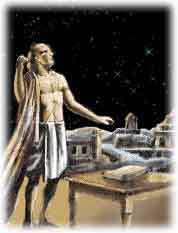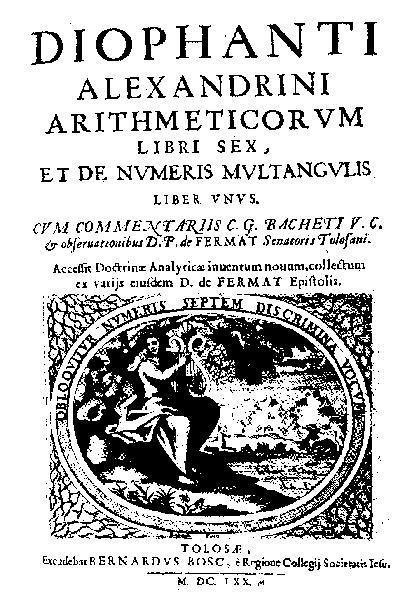Storytelling Science
Aryabhata and Diophantus' son
Amitabha Mukerjee
Appeared in the Hindustan Times November 2004.
You are hiking through primeval forest, and suddenly you stumble across a stone block. There are creepers growing on it, but something makes you rub off the muck. Slowly, you find this cryptic message emerging :Here lies the tomb with the remains of Diophantus: artfully it tells the measure of his life. The sixth part of his life God granted him for his youth. After a twelfth more his cheeks were bearded. After an additional seventh he kindled the light of marriage, and in the fifth year he accepted a son. Alas, a dear but unfortunate child, half his father's life he had lived when chill Fate took him. He consoled his grief in the remaining four years of his life. By this devise of numbers, tell us the extent of his life.You come home, and find a book called Fermat's Last Theorem by Amir Aczel. There you see that Diophantus was a Greek philosopher from approximately 250 AD, who wrote several books of problems, all of them requiring integer solutions. After him, any problem where only integer solutions are allowed came to be known as "Diophantine Equations".
Many months later, you are eating appam with a friend from Kerala, when he shows you an old palm leaf, about half a meter by ten cm, across which are fine engravings in ancient Malayalam. This is Bhaskara's commentary on the ancient text "Aryabhatiyam", and you find that the text has problems such as:

Fictionalized picture showing Aryabhata at Nalanda University. It is night and the stars are out; Aryabhata also made startling contributions to astronomy. IMAGE: Mathemajik
Find the integer which leaves a remainder 1 when divided by 2,3,4,5,6 and is exactly divisible by 7.To solve this, you see that 60 × n + 1 will leave a remainder 1 when divided by 2,3,4,5,6. Proceeding with different n you quickly find a solution: 301. (There are many larger solutions.) And it dawns on you: this is a Diophantine equation!Aryabhata, you find from your son's class VI textbook, lived in Bihar around 500 AD. You see, in those days Bihar had not been tainted by the cow-fodder scam, and was in fact a very advanced civilization. Aryabhata studied at Nalanda university, one of the oldest in the world. He was the first to propose a general method for solving Diophantine equations like 3x+5y = 1. In S. Balachandra Rao's Indian Mathematics and Astronomy, you find that such equations were considered extensively in the ancient Vedic text Shulvasutras, the more ancient parts of which may date back to 800BC. Aryabhata's method of solving such problems, called the kuttaka method, was elaborated by Bhaskara (621AD). Kuttaka means pulverizing, breaking into small pieces, and the method involved rewriting the original factors in terms of smaller numbers. Today this is the standard method for solving first order Diophantine equations. Note that Diophantine equations don't have unique answers - e.g. 3x+5y=1 has solutions (2,-1), (7,-4) etc.
After Aryabhata, Brahmagupta(628AD) handled more difficult Diophantine equations - in his Samasabhavana he laid out a procedure to solve Diophantine equations of the type 61x2 + 1 = y2. These methods were unknown in the west, and this very equation was posed as a problem in 1657 by the French mathematician Pierre de Fermat - however, its solution was found only seventy years later by Euler. Meanwhile, many centuries ago, the solution to this equation was recorded by Bhaskara II (1150AD), using a modified version of Brahmagupta's method (no wonder it is difficult; the lowest values are x = 226153980 and y = 1766319049).
The book by Diophantus is also the venue of what is possibly the most famous problem in mathematics. In 1637 Fermat scribbled on the margin of his copy of this book: "The equation an + bn = cn has no solutions for any n higher than two." And then he wrote, intriguingly:

The cover of Diophantus' 15 volume work, Arithmetica, of which only six volumes are available. IMAGE: Math Biographies
I have discovered a truly marvelous proof of this, which, however, the margin is not large enough to contain.This proof however eluded mathematicians for centuries. It became famous as Fermat's last problem, and was proved by Andrew Wiles only ten years ago.So: to return to our original problem - have you figured out Diophantus's son's age yet? No? Well - the problem says that the son lived to half his father's life. From the other half, if you take away 1/6th + 1/12th + 1/7th then you are left with with 5+4 = nine years. So 3/28th of his age was 9, so Diophantus turns out to have lived till 84, and his son till 42.
Now, don't just sit there! Get out your pencil and try solving some diophantine equations with some kids. Help them explore this meeting ground of two ancient civilizations.